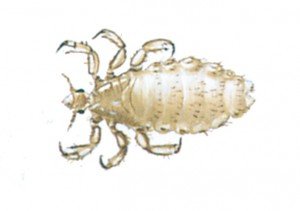
(Latin: Pediculus humanus var. capitis)
The head louse attaches its eggs firmly to hairs close to the scalp. The eggs are extremely tenacious and can only be removed from the hair by using a fine comb and much effort. Even frequent washing of the hair may not be sufficient to remove them.
The empty eggshells remain on the hair and move outwards as it grows. Under a lens they can be distinguished from unhatched eggs, because they are more transparent and they lack the ‘lid’.
As already mentioned, lice require a blood meal twice a day, and at ordinary room temperatures a head louse can only survive a couple of days when not living on a human.
Head lice do not transmit diseases.
They can be controlled by special preparations, but these do not usually kill the eggs, so treatment has to be repeated several times at intervals of 4-5 days.




